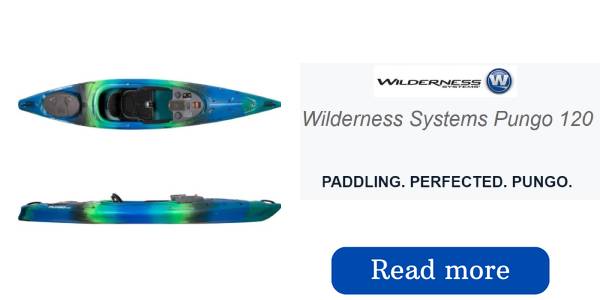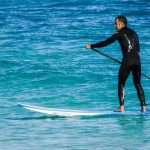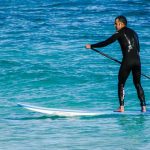In 1940, John Ah Choy, a Hawaiian local, invented stand up paddling. When his age prevented him from getting on his surfboard, he found it easier to stand and use a canoe paddle to propel himself from the shore.
Laird Hamilton, a local of Hawaii, went beyond what was thought to be achievable on a Stand Up Paddleboard when he traveled from one isle to the next and embraced the overwhelming waves during his journey.
He was convinced that Stand-up paddle boarding was a great form of exercise, and likened it to pushing a small car up a hill, since they burned the same amount of calories.
As time went on, the style and structure of boards and paddles changed drastically, resulting in a wide selection of them in the surf and other water sport stores. Stepping into any surf shop, you can easily find a board that will suit you, and from that single purchase you were hooked, starting your voyage into SUPing.
So why would you want to start stand-up paddleboarding? What attracts so many people to the activity of canoeing or kayaking?
It might be the toned muscles of the surfers riding the waves or the woman accompanied by her little boy savoring the experience.
Perhaps going out on the ocean and appreciating the calmness of the waves and its natural beauties while treating oneself to some peace was the appealing factor. No matter why you want it, it is essential to have the appropriate tools and to receive the correct guidance concerning what will be effective and what will not.
Let us take a break to analyze the process of finding and obtaining the best paddleboard suited to you; there are numerous elements that will determine whether you have the right equipment and if you do, you will be able to get everything you want out of your SUP adventure.
STAND UP PADDLING AND HOW TO CHOOSE THE RIGHT SUP FOR YOU
Entering a store that sell items for water activities can be overwhelming due to the large variety of merchandise available. It can be difficult to make a decision as to what to buy due to the vast amount of products that need to be evaluated. Before becoming overwhelmed, take a moment to breathe, be patient, and savor the initial step towards sailing.
Many considerations and queries must be examined, so keep calm and relish the beginning of your aquatic adventure.
For this issue, we will be examining the top boards and accessories for open-sea surfing and wave-riding, so that you can maximize the potential of your equipment and the awesome adventure of being out in the water!
We are going to investigate the characteristics of a Stand-Up Paddleboard that make it an ideal ocean and wave-riding vehicle. Then we will explore how the riders’ weight, size, and capability affect which board will be most suitable for them.
RAIL DESIGN
The shape of the rail has a big impact on one’s aptitude to utilize waves, because it is what permits movement from left to right and gives traction against the wave’s surface. A tapered deck to rail design is the best choice if you’re looking for a great wave riding experience.
The deck should start at its widest point at the centre and narrow towards the rail before sharply angling down at the rail’s edge. Tapered Rails allow you to maintain a better hold on the wave face, while still maintaining the same pace as you make turns.
TAIL SHAPE
The tail of surfboards, SUPs, and boats has always been an ongoing discussion as it is perceived differently by those who are passionate about wave riding, based on how it affects the performance of the board.
There are a variety of shapes that are commonly seen, such as the swallow tail, Box or squash tail, and the extremely popular rounded pin.
When picking the appropriate stand-up paddleboard (SUP) for your needs and what you would like to do on the ocean, the shape of the tail is an important factor, particularly when you advance and start taking on more challenging waves.
Let’s investigate each form’s features and how they adjust and shift how your board behaves.
- Squash, Box, or square tail – This shape allows for a punchier approach to the wave and greatly increases your top to bottom riding ability. The shape of the tail allows you to push out more water on every turn, therefore, keeping you in the pocket (Breaking point) of the wave.
This tail shape is great on waves that are small and overhead and will suit most paddlers
- Rounded Pin – I am a big fan of this tail shape and use it on most of my boards as the rounded tail allows you to flow through sections of the wave without losing speed.
Your turning ability is smooth and very responsive, and the shape works well on slightly bigger waves.
- Swallow or Fish Tail – This tail shape is incredibly popular for smaller boards and light riders. The two points of the tail aid the fins in grabbing the water or face of the wave on tight and quick turns.
The action when on the wave face feels very responsive to weight adjustments and very fast on open face swells.
That’s a lot of knowledge to take on board, however, when beginning, the Squash shape will be the ideal tail to opt for since it’s the most modifiable shape for the conditions you’ll be engaging in early on.
CONCAVE
The indentation in the underside of the board on the lower deck helps water to hurry beneath the board, resulting in an enhanced maneuverability and velocity of the stand-up paddleboard. The depth of concave can have a noteworthy impact on the board’s overall performance since an excess of concave can be an impediment when the swell and wave conditions worsen.
I personally think that the center concave feature of the board, which runs from the center to just past the first two fins, improves the board’s responsiveness and helps it turn more easily while still allowing it to maintain speed in the turns.
FIN MATERIAL
At the outset, there are several modes of fin configurations for surfing stand-up paddle boards. Fins on a board not only enable a board to turn, but are also a major factor in the board’s thrust capability. The speed and agility of your fin setup is dependent on what the item is made of.
Fins made of hardened and firmer polyester won’t flex or bend, enabling you to track a direct path on the swell and hold your speed. Fins made of composite or plastic materials tend to bend slightly when turning due to the speed and pressure involved, resulting in a slight loss of speed or power.
The best way to understand this is to imagine a car with slick tires turning around a sharp corner. As the vehicle drives into the curve, the tires’ grip begins to lessen, resulting in a reduction in speed for the car, and thus, the driver must speed up the engine to stay on course and maintain the same pace.
Imagine the same automobile with brand-new rims and the tires have a perfect tread pattern, so when the motorist takes the corner, the tires firmly grasp the pavement allowing the car to remain at the same speed or keep moving around the curve without having to press down more on the accelerator.
The glass fins that have a better hold on the road are more rigid, meaning that you don’t have to expend more effort when you are turning yet you maintain the board’s acceleration and velocity.
Beginning your journey and selecting the proper board to ride the swells can be made easier with the help of a softer, slightly flexible fin, as it will let you slow down fast turns, granting you the opportunity to regulate your board’s activity and giving you the opportunity to conform to the thrust and direction of the waves.
Paddle Board Size – Key Takeaways
- SUP dimensions: The four key paddle board dimensions to consider when selecting the most suitable size are length, width, thickness, and, most importantly, volume.
- How long is a paddle board? The length of the SUP depends on what it’s designed to do. The average SUP measures 10 to 11 feet in length – but there are boards that will go up to 14 feet, especially those designed for touring and racing.
- What size paddle board do I need for my height? For paddlers of average height, any standard-sized SUP – measuring 10 to 11 feet in length and 30 to 34 inches in width – will be a suitable choice.
- What size paddle board do I need for my weight? The SUP’s volume is the key factor to consider when choosing the right size paddle board for your weight. Take your weight (kilograms) and multiply it by your skill level (by 2 for beginners, 1.75 for intermediate-level paddlers, and 1.5 for advanced paddlers) to determine what size board you need.
- Best SUP size for beginners: Beginners should prioritize stability and ease of use, so a good all-around board – 10.5-11 feet long, 32-34 inches wide and 5 inches thick – would be a great fit for them.




